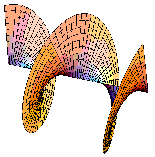

Side on, you can see that what you actually have is a tube of light
with a dark core.

The beam in this image has been focussed by a lens--the doughnut mode can be focussed or manipulated in exactly the same way as a gaussian laser beam. The focussed doughnut mode is of greatest interest in atom optics.
If you look at what the wavefronts are doing in this beam, you can
get some idea of why it has a dark centre. This is a picture of
wavefronts in the doughnut mode.

Along the central axis of the beam is a phase singularity. This is the sort of thing that we are interested in looking at close up.

All you have to do is calculate what the interference pattern between a doughnut mode and a plane electromagnetic wave. This is done fairly easily with a computer. The resulting pattern is then printed, and photographed onto normal slide film or holographic plates, and placed in the laser beam. For those with web browsers that support graphics, click on the picture for a full size version.
 Hologram to produce a doughnut mode with a charge one phase singularity.
Note: Reference Heckenberg, et al.
Hologram to produce a doughnut mode with a charge one phase singularity.
Note: Reference Heckenberg, et al.

 This is an image taken with a CCD camera of one of the first doughnuts
that we made. The hologram was created by
Shu-Yen Lee, who
also took the picture.
This is an image taken with a CCD camera of one of the first doughnuts
that we made. The hologram was created by
Shu-Yen Lee, who
also took the picture.
